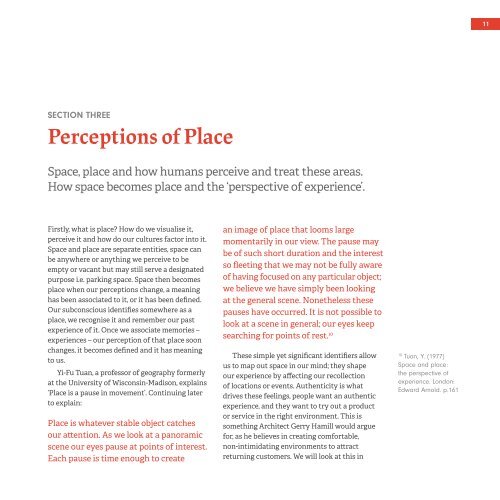Brand—Space
The impact of branding on physical space and the importance of creating an experience. Branded space, in the form of shops, museums, cafés and restaurants have an effect on us everyday. This study will look at the impact of physical space – how it can influence us and how it shapes our perceptions of brands and places. Including case studies from around the world and interviews with industry professionals.
The impact of branding on physical space and the importance of creating an experience. Branded space, in the form of shops, museums, cafés and restaurants have an effect on us everyday. This study will look at the impact of physical space – how it can influence us and how it shapes our perceptions of brands and places. Including case studies from around the world and interviews with industry professionals.
You also want an ePaper? Increase the reach of your titles
YUMPU automatically turns print PDFs into web optimized ePapers that Google loves.
11<br />
SECTION THREE<br />
Perceptions of Place<br />
Space, place and how humans perceive and treat these areas.<br />
How space becomes place and the ‘perspective of experience’.<br />
Firstly, what is place? How do we visualise it,<br />
perceive it and how do our cultures factor into it.<br />
Space and place are separate entities, space can<br />
be anywhere or anything we perceive to be<br />
empty or vacant but may still serve a designated<br />
purpose i.e. parking space. Space then becomes<br />
place when our perceptions change, a meaning<br />
has been associated to it, or it has been defined.<br />
Our subconscious identifies somewhere as a<br />
place, we recognise it and remember our past<br />
experience of it. Once we associate memories –<br />
experiences – our perception of that place soon<br />
changes, it becomes defined and it has meaning<br />
to us.<br />
Yi-Fu Tuan, a professor of geography formerly<br />
at the University of Wisconsin-Madison, explains<br />
‘Place is a pause in movement’. Continuing later<br />
to explain:<br />
Place is whatever stable object catches<br />
our attention. As we look at a panoramic<br />
scene our eyes pause at points of interest.<br />
Each pause is time enough to create<br />
an image of place that looms large<br />
momentarily in our view. The pause may<br />
be of such short duration and the interest<br />
so fleeting that we may not be fully aware<br />
of having focused on any particular object;<br />
we believe we have simply been looking<br />
at the general scene. Nonetheless these<br />
pauses have occurred. It is not possible to<br />
look at a scene in general; our eyes keep<br />
searching for points of rest. 10<br />
These simple yet significant identifiers allow<br />
10<br />
Tuan, Y. (1977)<br />
us to map out space in our mind; they shape Space and place:<br />
our experience by affecting our recollection<br />
the perspective of<br />
experience. London:<br />
of locations or events. Authenticity is what<br />
Edward Arnold. p.161<br />
drives these feelings, people want an authentic<br />
experience, and they want to try out a product<br />
or service in the right environment. This is<br />
something Architect Gerry Hamill would argue<br />
for, as he believes in creating comfortable,<br />
non-intimidating environments to attract<br />
returning customers. We will look at this in


